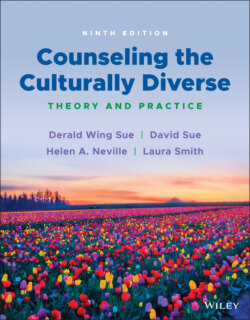Читать книгу Counseling the Culturally Diverse - Laura Smith L. - Страница 97
SUMMARY
ОглавлениеTheories of counseling and psychotherapy are influenced by assumptions that theorists make regarding the goals for therapy, the method used to invoke change, and the definition of mental health and illness. These assumptions are often rooted in culture‐ and class‐bound perspectives that can be so taken for granted by conventionally‐trained therapists that they are not even noticed. Counseling and psychotherapy have traditionally been conceptualized in Western individualistic terms that may lead to premature termination of counseling and underutilization of mental health services by marginalized groups in our society. Other culture‐bound values that may prove antagonistic to members of diverse groups include the following: focus on the individual, verbal/emotional/behavioral expressiveness, insight orientation, self‐disclosure, scientific empiricism, and separation of mental and physical functioning.
Culture‐related communication barriers are among the most relevant of these pitfalls for counselors, given that verbal communication is the basic vehicle by which counseling and therapy take place. When the counseling style of the counselor does not match the communication style of his or her culturally diverse clients, many difficulties may arise, including premature termination of the session, inability to establish rapport, and cultural oppression of the client. It is clear that effective multicultural counseling occurs when the counselor and the client are able to send and receive both verbal and nonverbal messages appropriately and accurately. Proxemics, kinesics, paralanguage, and other nonverbal factors are important elements of communication, and may be highly culture‐bound; effective mental health professionals understand these factors and shift are flexible in their helping styles.
In addition to this category, both class‐bound values and linguistic factors may prove biased against diverse client groups. For the therapist who comes from a middle‐ to upper‐class background, it is often difficult to relate to the circumstances affecting the client who lives in poverty. The phenomenon of poverty and its effects on individuals and institutions can be devastating. The lack of bilingual therapists and the requirement that clients communicate in Standard English may also limit progress in counseling and therapy. If bilingual individuals do not use their native tongue, many aspects of their emotional experience may not be available for treatment.
Family systems theory, while seemingly consistent with the collectivistic orientation of many diverse groups, may be equally culture‐bound, as may be manifested in marital or couple counseling, parent–child counseling, or work with more than one member of a family. For example, many Western beliefs and assumptions about healthy families may be incongruent with diverse groups, including: (a) placing a high premium on the free and open expression of emotion; (b) encouraging family members to prioritize their own unique selves above the family; (c) striving for an equal division of labor and authority among family members; and (d) holding the nuclear family as the standard.
Life in poverty also reflects a set of experiences that corresponds to a particular cultural standpoint—and it is one that many psychotherapists will be ill‐equipped to understand beyond their feelings of sympathy. Not only are poverty and classism overwhelmingly detrimental to the mental and physical health of clients, they are associated with a set of unintentional class biases that are known to affect helping professionals as well as the general public. Unless therapists work to identify and address their poverty‐related awareness, knowledge, and skills, their unaware classism will undermine their ability to work with lower‐socioeconomic‐class clients.
Full Counseling Session Analysis video (Part II) for “Barriers to Effective Multicultural Counseling”
Full Counseling Session Analysis video (Part II) for “Communication Styles and Counseling”
